Table Of Content
- Why Should You Learn Options Trading?
- Options Trading as Tools of Control – What Makes It Powerful
- Investors vs. Trader Approach on Options
- The Dangers of Options Trading When Going in Blind
- Calls and Puts – What are they?
- Buyers and Sellers: Two Sides of Every Option Contract
- Which Side is Easier to Start With?
- Key Terminology for Options Trading
- P&L of a Long Call
- P&L of a Long Put
- Selling Covered Call
- Selling Cash Secured Put
- Options Strategies to Hedge your Account
- Options Pricing and Greeks
- Essentials When Trading Options
Welcome to Our Options Trading Free Course, a complete guide built to help you understand and trade options. Whether you’re an investor looking to earn income from your portfolio, a trader aiming to generate consistent income, or simply someone curious about how options really work, this resource walks you through every essential concept step by step.
You’ll learn how options can hedge risk, amplify returns, and create monthly income streams, all while understanding how to manage the risks that come with them.
Options trading when used responsibly, are not gambling tools, but instruments of control and precision.
This course will help you understand those instruments.
By the end of this free options trading course, you’ll understand how to read option chains, build basic positions, and define your risks. But remember, options aren’t simple. Real skill comes from practice, patience, and experience in the live market.
Having a community behind you makes that journey faster and more rewarding. Traders and mentors who share insights, spot opportunities, and guide you through both the wins and the rough patches. When you learn alongside others who’ve walked the same path, every trade becomes profitable through the lessons you learn.
Why Should You Learn Options Trading?
Understanding options is like unlocking a new dimension of investing. Unlike traditional stock trading, where you buy and hold. Options allow you to customise your risk, control your capital, and profit in multiple market conditions. Whether markets rise, fall, or move sideways, options can be designed to fit your outlook and objectives.
However, that same flexibility can become a double-edged sword. With so many strategies available, traders often over-leverage or over-trade, exposing themselves to risks far greater than they intended. It’s not the options themselves that are dangerous, it's how they’re used and understood.
Even if you don’t plan to become an active options trader, every serious investor should at least understand how options work. They influence how large institutions hedge, how volatility is priced, and how market sentiment shifts.
Flexibility and Leverage Over Traditional Stocks
With stocks, your only play is direction: you buy if you expect a rise, you sell if you don’t. Options multiply your flexibility. They let you control 100 shares of stock with a fraction of the capital, and—crucially—you can limit your risk while doing so.
That means you can participate in the same price movement without tying up large amounts of money or exposing your account to unlimited downside.
For example, buying a call option might cost $200–$300 to control $10,000 worth of shares. The same move in the stock could earn a similar dollar profit, but your percentage return with options is far higher, and your loss is capped at the premium you paid.
This leverage with defined risk is what makes options a professional’s tool, not a gambler’s toy.
Using Options to Profit in Any Market Direction
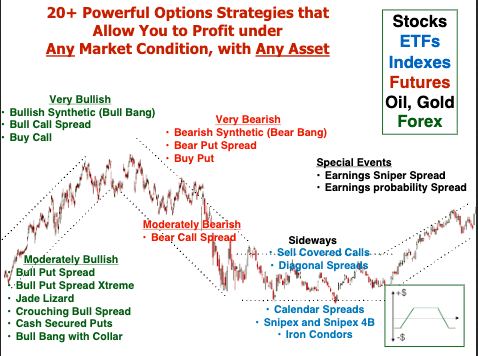
Chart by Piranha Profits Team
One of the biggest advantages of options trading is that you can profit in any market direction up, down, or even sideways. Traditional stock traders only make money when prices rise.
Options traders, on the other hand, can structure trades that benefit from movement, stagnation, or even volatility itself. This flexibility is what makes options such a dynamic tool.
Think of options strategies as two different games: one plays the movement, the other plays the clock. The first is directional trading, the second is non-directional trading.
Directional Options Trading
When you have a clear bias on where the market is heading, bullish or bearish. You can build a position that benefits from that movement using a fraction of the capital you’d need to buy shares outright.
For example, instead of buying 100 shares of a $100 stock (which costs $10,000), you could buy a call option for maybe $300.
If the stock rises, your option’s value can increase significantly, giving you a much higher percentage return with your loss limited to what you paid.
Non-Directional Options Trading
Even when the market refuses to pick a direction, options traders can still profit.
Non-directional trading focuses on time decay and volatility management — earning consistent income when prices move less than expected.
These setups, often called neutral or income strategies, involve selling option spreads or combinations that benefit when the market stays range-bound. As time passes and options lose value, the trader collects the remaining premium.
This is the quiet strength of options: the ability to get paid for simply being right about nothing happening.
Options Trading as Tools of Control – What Makes It Powerful
Unlike speculative gambling, options give you the power to define your risk, set your reward, and decide how long you want to stay in the trade. You’re no longer reacting to market swings.
Before diving into the mechanics of calls and puts. It’s important to understand why professionals use options in the first place. Their true power lies in how they let you manage risk, generate income, and even acquire stocks on your own terms.
Hedging and Risk Control with Options Trading
Markets don’t move in straight lines. Even the strongest stocks experience drawdowns, and long-term investors can use options to cushion those hits. Options make that possible through protective puts, collars, and other hedging spreads.

Chart of the S&P 500 from Jan 2023 to Nov 2025, highlighting several major downturns and minor pullbacks.
Think of it like buying insurance for your portfolio, you pay a small premium to limit potential losses if the market turns against you. It’s not about predicting crashes; it’s about staying in the game when they happen.
Get Ahead and Learn how to Buy Protective Puts
Earning a Monthly Income by Selling Calls
Options can also act as a steady income engine. By selling covered calls on stocks you already own or credit spreads on stable setups, you collect option premiums upfront. If the options expire worthless, you keep the premium as profit.
This approach appeals to investors who want their portfolio to “work” for them earning cash flow while still holding quality stocks long-term. Over time, that steady income can buffer drawdowns and compound returns.
Get Ahead to Learn How to Sell Covered Calls
Buying Stocks at a Discount by Selling Puts
Wouldn’t it be nice to get paid while waiting for your favorite stock to drop to your ideal entry price? That’s exactly what cash-secured puts (CSPs) allow.
You sell a put option at the price you’d be happy to buy the stock. If the stock falls there, you’re assigned the shares, effectively buying at a discount. If it doesn’t, you still keep the premium you collected.
Either way, you win: you get paid to wait.
Get Ahead to Learn how to Sell Cash Secured Puts
Advanced Risk Defined Options Setups
For active traders, the flexibility of options goes far beyond buying or selling calls and puts. You can combine contracts into structured setups, known as spreads, that define both maximum loss and potential gain.
This lets traders design strategies for every market condition — directional when they expect movement, and non-directional when they expect stability.
Used with discipline, this flexibility gives traders mathematical precision the ability to plan outcomes before a trade even begins.
Investors vs. Trader Approach on Options
Both investors and traders use options, but their goals differ.
Investors focus on long-term consistency using covered calls, cash-secured puts, or hedging spreads to grow and protect their portfolio. Their aim is steady income and compounding, not quick wins.
Still, even patient investors sometimes feel the urge to speculate. Taking small directional trades isn’t wrong, as long as it’s done with clear limits and sensible capital allocation, without disrupting the main investing agenda.
Traders, meanwhile, thrive on shorter-term opportunities. They use spread setups and volatility-based trades to capture price movement efficiently. Efficient traders manage risk and reward carefully, avoiding oversized bets for minimal gains unnecessarily.
Both mindsets can complement each other, what matters is knowing when you’re investing, when you’re trading, and lastly managing risk.
|
Investor Approach |
Trader Approach |
|
|
Primary Goal |
Build Long Term Wealth and Consistent Income |
Generate Short to Medium Term Profits Through Active Management |
|
Mindset |
Conservative, focused on capital preservation and yield |
Opportunistic, focused on movement, volatility and events |
|
Typical Strategies |
Covered Calls , Cash Secured Puts , Protective Puts |
Spreads, Directional Plays, 0DTE Trading |
|
Risk Management |
Defined and Conservative; aims to minimise drawdowns and small consistent gains |
Smartly Taking more risks to profit from opportunities |
The Dangers of Options Trading When Going in Blind
The same leverage that multiplies profits can just as easily magnify losses.
Many beginners jump in without understanding how Greeks, time decay (DTE), or volatility affect their positions. Others trade without a plan, go “all in,” or hold naked positions with undefined risk.
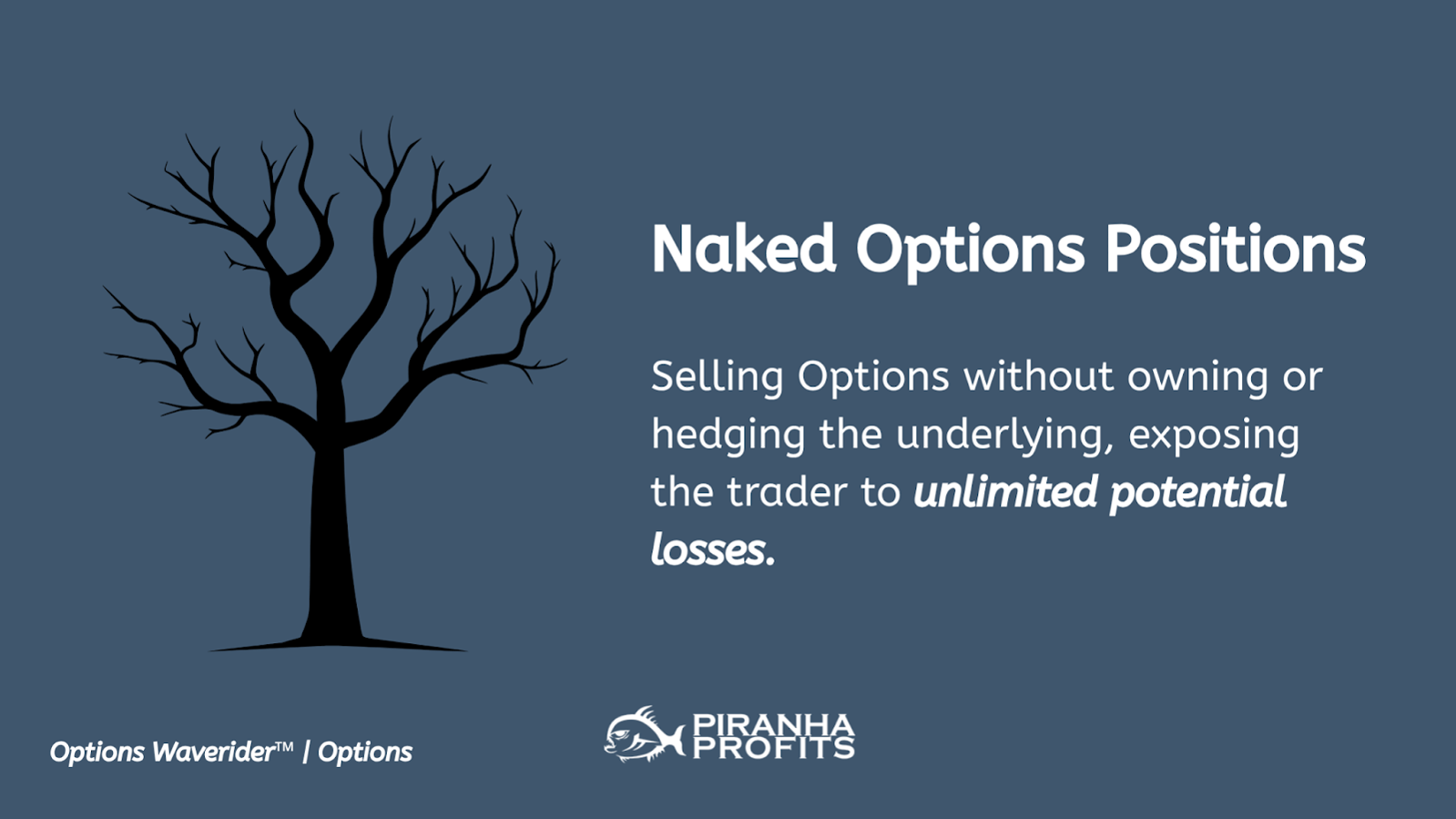
The truth is simple: options reward precision, not guesswork. Without risk control and a clear understanding of the underlying asset, even a smart trade can turn into an expensive lesson.
Calls and Puts – What are they?
Before you get too excited and pull up your favorite stock’s options chain, it’s worth understanding what calls and puts actually are. Once you grasp these two building blocks, that complicated-looking table suddenly makes sense every price, strike, and expiry becomes clear.
Call Option Definition and Analogy
A call option gives the buyer the right to buy a specific quantity of the underlying stock at the strike price before the expiration date. If the stock price rises above the strike price before expiration, the call option holder can exercise their right to buy the stock at the lower strike price, potentially making a profit.

Imagine you’ve found a bike you like, but you’re not ready to buy it outright. Instead, you pay $15 to rent the option to buy that bike for $100 anytime within the next month.
During that month, the bike’s market value jumped to $150. Because you hold the option, you still have the right to buy it for $100, even though everyone else must pay the new higher price.
Here’s the math:
Total spent: $15 (option rental, or “premium”) + $100 (purchase price) = $115
Market value of the bike: $150
You’ve effectively paid $115 for something now worth $150, locking in a $35 profit all because you controlled the purchase with an option instead of buying outright.
Put Option Definition and Analogy
A put option is the opposite. It gives the buyer the right to sell a specific quantity of the underlying stock at the strike price before the expiration date. If the stock price falls below the strike price before expiration, the put option holder can exercise their right to sell the stock at the higher strike price, potentially profiting from the price decline.

This time, you pay $5 to rent the option to sell the bike at a fixed price of $100, valid for one month. During that month, the bike’s market value drops to $80. Thanks to your option, you still have the right to sell it for $100, even though it’s now worth less.
Here’s the math:
Bike sold for: $100
Premium paid for the option: $5
Potential loss without the option: −$20 (if sold at $80)
Actual loss: only −$5, the premium you paid
In both cases, you pay a small fee upfront for control — the right, but not the obligation, to act later. If you don’t exercise your option before it expires, you simply lose that fee, much like forfeiting a rental deposit.
Why are Naked Positions Dangerous for Beginners
Now that you understand what calls and puts are, you should also know why naked positions are risky. A naked position means selling an option without owning or hedging the underlying stock.
Most brokers also restrict or block naked positions unless you meet strict margin and experience requirements. They do this because the risk is real.
A naked call has unlimited loss potential if the stock keeps rising. A naked put can force you to buy a collapsing stock at an inflated price. Holding several naked trades at once can wipe out an account very quickly.
Naked Call Option Example:
You sell a call on ABC with a $100 strike, collecting a $2 premium ($200). The stock then rallies to $200. Since you don’t own the shares, you must buy 100 shares at $200 ($20,000) to sell them at the strike price of $100 ($10,000).
Your total loss is the difference of $10,000, minus the $200 premium received — a net loss of $9,800.
Naked Call :
Maximum Profit: Limited to the premium received.Maximum Loss: Unlimited (stock can rise infinitely).
Breakeven: Strike Price + Premium Received.
Naked Put Option Example:
You sell a put on ABC with a strike price of $100, earning a $2 premium ($200). The stock then crashes to $50. You’re obligated to buy 100 shares at $100, now worth only $50 each — a $5,000 loss minus the $200 premium, or $4,800 total.
And now you’re stuck owning a falling stock — one that could continue dropping if the company’s fundamentals weaken further.
Naked Put:
Maximum Profit: Premium received.Maximum Loss: Strike Price × 100 – Premium received (if stock goes to $0).
Breakeven: Strike Price – Premium Received.
Buyers and Sellers: Two Sides of Every Option Contract
Now that you understand what calls and puts are, it’s time to look at the two sides who make the trade possible. The buyer and the seller (also called the writer). Every option contract has both sides, each with its own rewards, risks, and mindset.
The Buyer: Paying for Opportunity
The buyer pays a premium to gain the right (but not the obligation) to buy or sell the underlying stock at a fixed price.
|
Goal |
To Profit From Movement in The Stock Price |
|
Risk |
Limited to Only the Premium Paid |
|
Reward |
Potentially Unlimited(for calls) or large (for puts) if the stocks moves sharply in their favor |
|
Mindset |
Opportunistic. Buyers are speculating on direction or volatility. Risk a small amount for a chance of a big payoff whilst time works against them. |
The Seller: Getting Paid for Taking Obligation
The seller receives the premium upfront and takes on the obligation to fulfill the contract if the buyer exercises it.
|
Goal |
To Collect Income By Selling their Obligation to the Buyer |
|
Risk |
Can be large if market moves sharply against their position |
|
Reward |
Limited to the Premium Collected |
|
Mindset |
Strategic and Disciplined. Sellers behave like insurers, earning small but steady returns with time working in their favor. |
Let’s Put it All Together…
|
Call |
Put |
|
|
Buyer |
Have the RIGHT to BUY 100 Shares at the Strike Price |
Have the RIGHT to SELL 100 Shares at the Strike Price |
|
Seller |
Have the OBLIGATION to SELL 100 Shares at the Strike Price |
Have the OBLIGATION to BUY 100 Shares at the Strike Price |
Which Side is Easier to Start With?
Most beginners think buying options is simpler because your loss is capped at the premium you pay. In practice, selling options are more forgiving — if done correctly.
When you sell an option, you’re effectively taking the other side of the buyer’s bet. Time now works in your favor, because every day that passes without a big move reduces the option’s value. As a buyer, you need the market to move in the right direction and move sharply enough for you to make a profit.
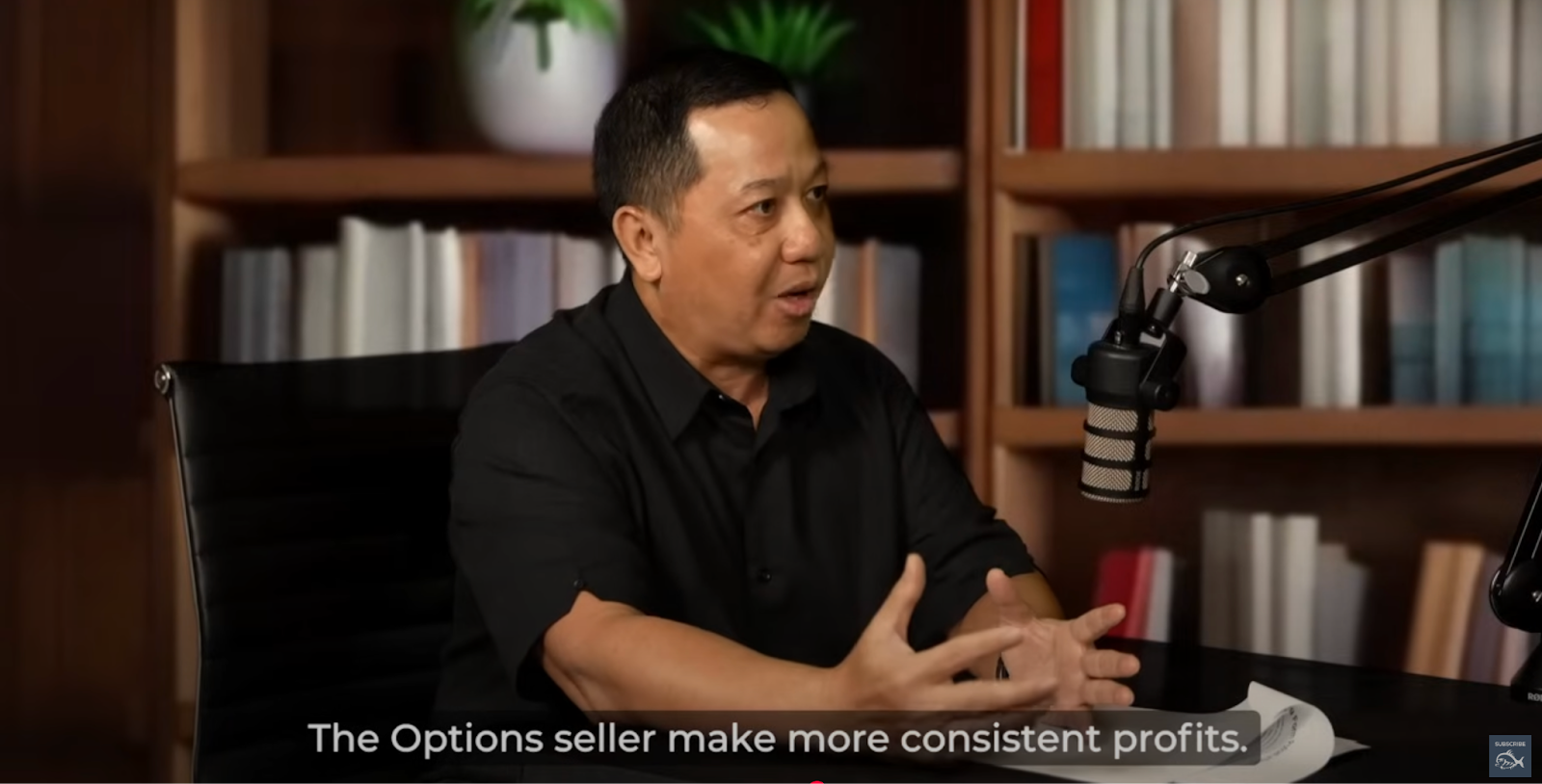
However, selling naked options without owning the shares or setting aside enough capital is risky. If the market moves sharply against you, losses can pile up fast. That’s why new traders should never sell options “uncovered” or Naked.
The safer path begins with defined-risk selling, where you understand exactly what you could lose before placing the trade. Think of it as earning steady income for taking calculated risks.
In short: buyers pay for potential, sellers get paid for patience. And patience, in options, is often the more reliable teacher.
Hear from our Options Mentor Bang Pham Van on why being a seller is a better way to start.
Key Terminology and Examples of Options Chain Table
Before you place your first trade, it’s essential to understand how to read an options chain table you’ll find on your broker’s platform (like the one shown below). It looks intimidating at first, but every column simply describes the details of each option contract.
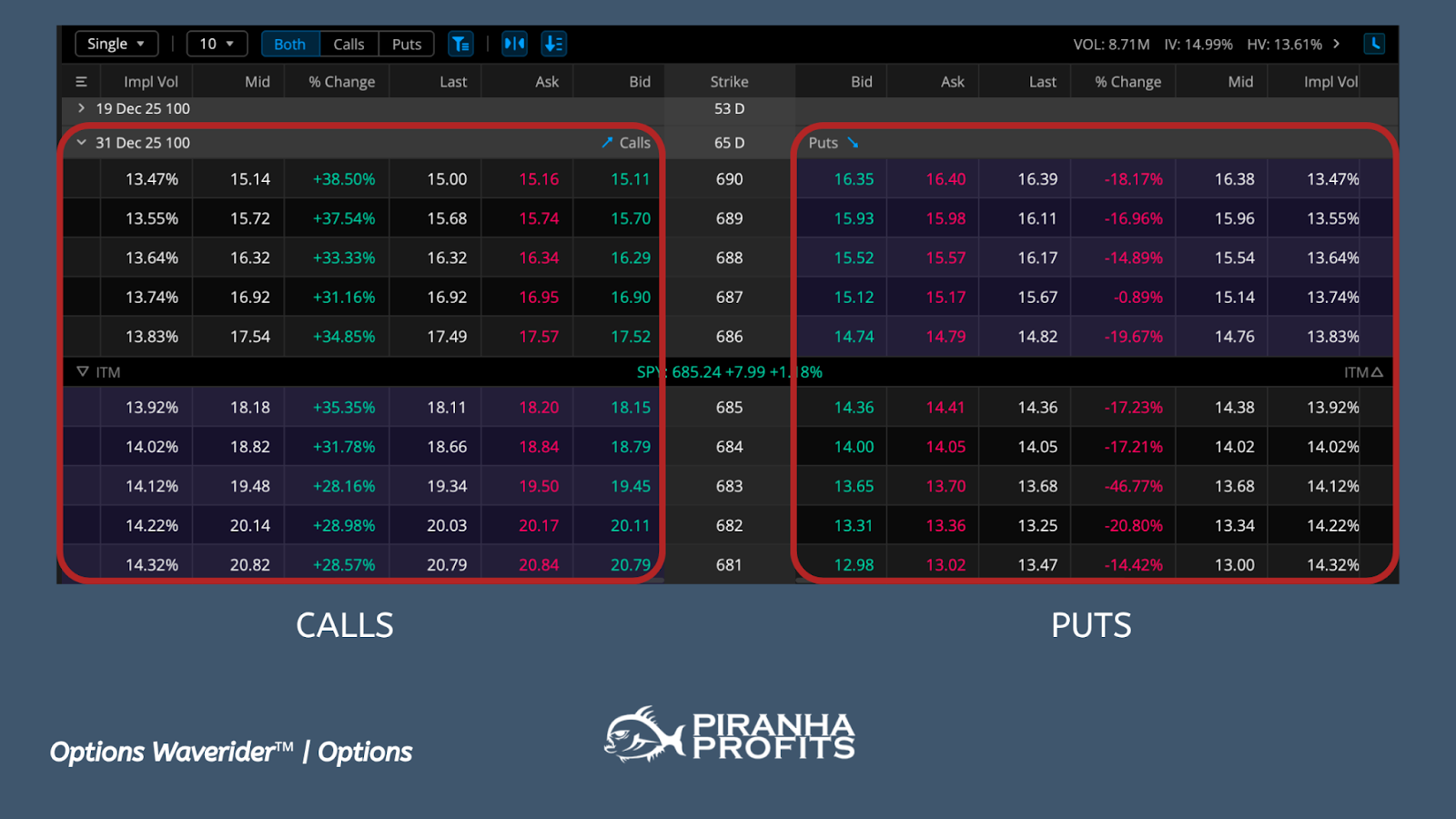
When you open an options chain(as shown above), you’ll always see two sides(when toggled) Calls and Puts.
The Calls section lists contracts that give you the right to buy the stock at the strike price.The Puts section lists contracts that give you the right to sell the stock at the strike price.
Strike Price
The strike price is the specific price at which your option gives you the right to buy (if it’s a call) or sell (if it’s a put) the stock.
Think of it as a target price that defines your deal.
For a call option, you’re locking in the right to buy the stock at that strike price no matter how high the market goes.For a put option, you’re locking in the right to sell at that strike price even if the market drops lower.
In the example above, the strike prices are listed in the middle column — 686, 687, 688, 689, 690, and so on.
Premium (Bid, Ask, and Last)
The premium is the market price of the option — the cost for buyers and the income for sellers.
You’ll see three columns related to this:
Ask: The lowest price sellers are currently willing to accept
Last: The most recent transaction price.
In the example, a 690 Call has a bid of 15.11 and an ask of 15.16. That means if you buy, you’ll likely pay around $15.16 × 100 = $1,516 per contract (since each contract covers 100 shares).
Contract Size for Options
Each standard options contract for stocks represents 100 shares of the underlying stock. So, a premium of $15.00 means the total value of that contract is $1,500.
1 Contract is Equal to …
|
For Stock/ETF/Index |
100 Shares |
|
For Crude Oil |
1000 Barrels |
|
For Natural Gas |
10,000 MMBtu |
|
For Gold |
100 Ounces |
|
E-mini S&P500 Futures (/es) |
50 Futures |
In the Money (ITM), At the Money (ATM), and Out of the Money (OTM)
These describe how the option’s strike price compares to the stock’s current price (SPY is $685.24 in this example).
In the Money (ITM): For calls, strike prices below 685.24; for puts, strike prices above 685.24.At the Money (ATM): The strike closest to the stock’s current price — roughly 685 here.
Out of the Money (OTM): For calls, strike prices above 685.24; for puts, strike prices below 685.24.
ITM options cost more because they already have intrinsic value. OTM options are cheaper but riskier.

Expiration Date (DTE)
Options don’t last forever — they expire. In the example, the chain shows expirations for 31 Dec 2025 (100 days left). The number of days remaining until expiration is often displayed as DTE (Days to Expiry).
As an option gets close to expiration, time decay (Theta) accelerates. Each passing day, the option’s extrinsic value which is the portion based on time and volatility drops faster. By the final week, even small price movements may not offset this decay.

When an option reaches expiration, one of two things happens:
If the Option Expires In the Money (ITM):
Call Option: The buyer has the right to buy 100 shares at the strike price. If you’re the seller, you’ll be assigned and must sell those shares (or buy them first if you don’t own any).
Put Option: The buyer has the right to sell 100 shares at the strike price. If you’re the seller, you’ll be assigned and must buy those shares.
Assignment is automatic if the option finishes in the money, unless the position is closed or rolled before expiration.
If the Option Expires Out of the Money (OTM):
The option becomes worthless and expires automatically.The buyer loses the premium paid.
The seller keeps the entire premium as profit.
Implied Volatility (IV)
Shown in the Impl Vol column, this percentage reflects the market’s expectation of how volatile the stock will be.
Higher IV means higher option prices because the market expects bigger moves. Lower IV means calmer expectations. In this example, IV ranges around 13–14%, indicating a relatively stable outlook.
|
IV Level |
Impact on Options Price |
Benefits |
|
High IV |
Higher Premiums |
Seller can Collect Larger Premiums |
|
Low IV |
Lower Premiums |
Buyers gets to Pay Lesser |
|
Rising IV |
Prices Increases |
Existing Buyers Gain as Option Value Rises |
|
Falling IV |
Prices Decreases |
Existing Sellers Gain as Option Value Drops |
% Change and Volume
% Change shows how much the option’s price has moved today — green numbers for gains, red for drops.Volume (not shown in your cropped image but usually nearby) tells you how many contracts traded today. Higher volume usually means better liquidity and easier fills.
P&L of a Long Call
Now that you understand the key terms in options trading, let’s see how they come together in real trade, starting with how profit and loss (P&L) actually play out in different option setups.
A long call typically works best when your market bias is strongly bullish, when you expect a sharp upward move in price within a set time frame. Traders often use long calls:
When they anticipate breakouts from consolidation zones,Ahead of momentum-driven rallies, or
When volatility is relatively low and premiums are cheaper.
Used at the right time, it’s a clean way to leverage upside potential while keeping downside risk fixed.

P&L Chart of Long Call by Piranha Profits
This chart shows how a long call behaves as the stock price changes. It helps you see how much you can gain or lose depending on where the stock ends up at expiration.
The horizontal axis shows the stock price at expiration.The vertical axis shows the profit or loss.
At the start, you pay a premium of $4 (x100 = $400), which is your maximum risk – shown by the red section.
Your strike price is $90, and your breakeven is $94 (strike + premium).
If the stock stays below $90, you lose $400.
Above $94, you start making money. Every $1 increase adds about $100 profit.
The green line shows your potential profit at expiration, unlimited as the stock rises.
The dotted curve shows what your profit/loss would look like before expiration, when there’s still time value (extrinsic value) left.
Example: PG 90 Call at $4
Strike Price: $90Premium (Cost): $4 × 100 shares = $400 total
Breakeven Price: Strike + Premium = $94
Advantages and Risks of Buying Calls
A long call gives you limited risk (the premium paid) and unlimited upside. You can control high-priced stocks with little capital and potentially earn outsized returns when the stock moves large and fast in your favor.
However the trade isn’t easily profitable. To profit, the stock must climb past the strike plus the premium before expiration. If it drifts sideways, falls, or moves too slowly, the option loses value. Time decay and falling volatility both work against you.
P&L of a Long Put
A long put works best when your market bias is strongly bearish, when you expect a sharp decline in price within a specific timeframe. Traders typically use long puts:
When they anticipate a downtrending marketWhen volatility is relatively low and option premiums are cheaper.
Used at the right moment, a long put lets you profit from falling prices while keeping your risk limited to the premium paid.
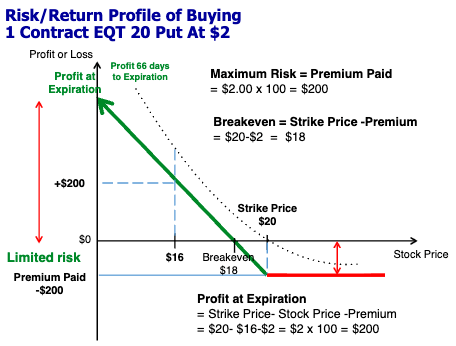
P&L Chart of Long Put by Piranha Profits
This chart shows how a long put performs as the stock price changes. It’s the mirror image of a long call. Here, you profit when prices fall, not rise.
The horizontal axis shows the stock price at expiration.The vertical axis shows your profit or loss.
You pay a premium of $2 (×100 = $200), which is your maximum risk shown by the red section.
Your strike price is $20, and your breakeven point is $18 (strike − premium).
If the stock stays above $20, your put expires worthless, and you lose $200.
Below $18, you start making profits.
The green line shows profit at expiration — the lower the stock falls, the greater the profit (until it bottoms at zero).
The dotted curve shows how your option might gain or lose value before expiration, when there’s still time (extrinsic) value left.
Advantages and Risks of Buying a Long Put
A long put lets you profit from falling prices with limited risk(premium paid). It’s a simple way to hedge or speculate on a down move without shorting stock.
However, the stock must fall quickly and deeply for the trade to be profitable. If it moves sideways or drops too slowly, time decay erodes the option’s value. Falling volatility can also hurt your position.
Selling Covered Call
A covered call is an income strategy for investors who already own 100 shares. Instead of letting the stock sit idle, you sell call options against your holdings to collect regular premium income. It’s a way to make your portfolio work for you, generating cash flow while still owning quality companies.
The goal isn’t to predict market direction but to enhance returns in a neutral or mildly bullish market. If the stock stays below the strike price, you keep both your shares and the premium. If it rises above, your shares may be sold (called away) at the strike — still at a profit, though you give up further upside.
The Covered Call Strategy
A covered call combines:
Owning 100 shares of a stock, andSelling a call option on those same shares.
You earn income upfront (the premium), which slightly cushions your downside and compounds over time.
Covered calls are best for long-term investors who are comfortable holding the stock and don’t expect explosive near-term growth.
Learn more: Covered Calls Explained in Detail →
Important Points to Note When Selling Covered Calls
Stock Selection of the Underlying Stock
Choose high-quality, stable stocks that you’re genuinely comfortable holding long term, even through short-term pullbacks. Since selling calls means you already own the stock, avoid speculative or highly volatile names that can swing wildly. Remember, the goal isn’t to get rid of your shares but to earn steady income from them.
Don’t assume your stocks will always be called away — calls can expire unexercised, letting you keep both your shares and the premium.
Entry Strategy for Covered Calls
Selling calls when implied volatility is modestly elevated will increase the premium income. Choosing strike prices above your cost basis also allows room for some capital gains before assignment.
When selling a covered call, look for setups with a higher Delta (indicating a realistic chance of being in the money), a DTE long enough for the trade to develop, and a premium return that justifies the effort compared to simply holding the stock.
The goal is to strike a balance, earning meaningful income without taking on unnecessary assignment risk or tying up your capital for too little reward.
Exit Strategy for Covered Calls
Selling calls is generally a buy-and-hold enhancement, not a short-term trading tactic. However, if the stock price moves well above your strike price and your call goes deep in the money, you may consider rolling the position, closing the current call and opening a new one at a higher strike or later expiration. This helps you reposition without losing your shares if you’re not ready to let them go.
In this case, assignment means your 100 shares are sold to the call buyer at the strike price, so rolling gives you the flexibility to stay invested while still collecting additional premium income.
Selling Cash Secured Put
A cash-secured put (CSP) is a conservative income strategy used by investors who want to buy a stock at a discount while getting paid to wait. By selling a put option, you agree to buy the stock at a set price (the strike) if it drops there and in return, you collect a premium upfront.
If the stock stays above the strike, you simply keep the premium as profit. If it falls below the strike, you’ll likely be assigned the shares — and that’s all according to plan, because the strategy assumes you’re comfortable owning the stock at that lower price.
In short, cash-secured puts help you enter positions at better prices while earning income along the way.
Cash-Secured Put Strategy
A CSP combines:
Selling a put option at a price you’re alright to buy the stock.Setting aside enough cash to cover that potential purchase (hence “cash-secured”).
It’s a patient investor’s strategy, you’re getting paid for waiting. It works best in neutral to moderately bullish markets, where you don’t mind owning the stock if it dips slightly.
Learn more: How to Sell Cash-Secured Puts
Important Points to Note When Selling Cash Secured Puts
Stock Selection for Cash Secured Puts
Choose quality stocks you actually want to own, ones with strong fundamentals and steady performance. Avoid speculative or overly volatile names that could drop far below your strike price even though the premium may look attractive.
Entry Strategy for Cash Secured Puts
Pick a strike price that reflects where you’d be comfortable buying the stock, usually below its current market value. Look for setups with reasonable Delta, a DTE that gives enough time for it to develop, and a premium that offers a worthwhile return on your secured cash.
Exit Strategy for Cash Secured Puts
If the stock drops and your put moves deep in the money, you can roll the contract to a later expiration or lower strike to avoid immediate assignment.
Otherwise, if assigned, you’ll simply buy the shares at the agreed strike price and can later sell covered calls on them to start the next income cycle (the basis of the Wheel Strategy).
Options Strategies to Hedge your Account
Even well-constructed portfolios face risk when markets turn volatile or bearish. Options give investors a way to hedge losses.
One of the most straightforward ways to do this is by buying Protective Puts — a form of “insurance” that locks in the value of your holdings while allowing upside potential.
Protective Puts
A Protective Put is a defensive options strategy used by investors who already hold long stock positions. It involves buying a put option on the same stock to protect against potential declines in price.
Think of it as an insurance for your portfolio:
You pay a premium for the right to sell your shares at a predetermined strike price within a set period.If the stock’s price drops sharply, your put increases in value — offsetting losses in your stock holdings.
If the stock continues rising, your put may expire worthless, and the premium paid becomes the cost of protection — similar to paying for insurance you didn’t need to use.
How Does Protective Puts Work
You hold a stock.
Instead of selling and triggering taxes or missing potential upside, you buy a put option to protect it from a short term downturn.
If prices decline, gains from the put help offset the portfolio’s losses.
If prices rise, you still benefit from the upside, minus the cost of the put premium.
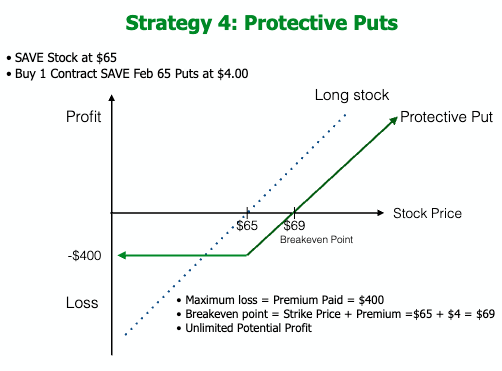
Protective Puts P&L Chart Options Waverider™ Piranha Profits
In the example, the Option Trader bought SAVE stock at $65 and buys a 65 strike put for $4 (or $400 per contract).
The maximum loss is limited to the premium paid ($400). Even if the stock collapses, the put gives the right to sell at $65.The breakeven point is $69 (stock price $65 + $4 premium)
Upside remains unlimited — if the stock rises, profits continue just like owning the stock outright, minus the $4 insurance cost.
Essentially, the protective put turns a regular stock holding into a defined-risk position, allowing investors to stay invested while cushioning against major short-term drawdowns.
Understanding Options Pricing and the Greeks
Options aren’t priced randomly, every premium you see reflects a combination of mathematics, probability, and market psychology.
An option’s price, or premium, is made up of two components:
1. Intrinsic Value – the amount an option is in the money
2. Extrinsic Value – the time and volatility portion that decays as expiration nears
Option Price = Intrinsic Value + Extrinsic Value
|
Intrinsic Value |
Extrinsic Value |
|
|
What is it |
The tangible Value of an Option |
Time and Volatility Value |
|
How is it Calculated |
Calls : Stock Price - Strike Price |
Options Premium - Intrinsic Value |
Understanding Greeks : What Moves Option Prices
The Greeks are measurements that explain why an option’s price changes. Each Greek isolates one key factor affecting an option’s value — such as stock movement, volatility, or time
|
Greek |
What It Measures |
Impact on Option Price |
|
Delta (Δ) |
The rate of change of the option’s price relative to a $1 change in the underlying stock. |
A call option with Δ = 0.6 increases $0.60 for every $1 stock rise. For puts, Delta is negative (-0.6). It also represents the probability the option will expire in the money. |
|
Gamma (Γ) |
The rate of change of Delta as the stock price moves. |
Gamma is highest when options are at the money and increases near expiration. It measures how fast Delta accelerates as the stock moves. |
|
Theta (Θ) |
The impact of time decay — how much value the option loses each day. |
A Theta of -0.05 means the option loses $0.05 in value per day, assuming all else stays constant. Time decay accelerates in the final 30–60 days before expiration. |
|
Vega (ν) |
Sensitivity to changes in implied volatility (IV). |
If Vega = 0.10, a 1% rise in IV increases the option price by $0.10. Longer-dated options have higher Vega because they’re more exposed to volatility shifts. |
|
Rho (ρ) |
The sensitivity of option price to interest rate changes. |
Rho matters mostly for long-term options — higher interest rates slightly increase call prices and decrease put prices. |
Essentials When Trading Options
Successful options trading isn’t just about selecting the right strike or expiry. The following tools help you identify setups and plan your capital.
Portfolio Tracker For Options Positions Visibility And Planning
As your options portfolio grows, keeping track of multiple strategies covered calls, cash-secured puts, spreads, and more becomes essential. A portfolio tracker gives you a structured view of every open and closed position, helping you make informed decisions instead of emotional ones.
The example below shows a sample Options Portfolio Tracker, which breaks down every position into key components:
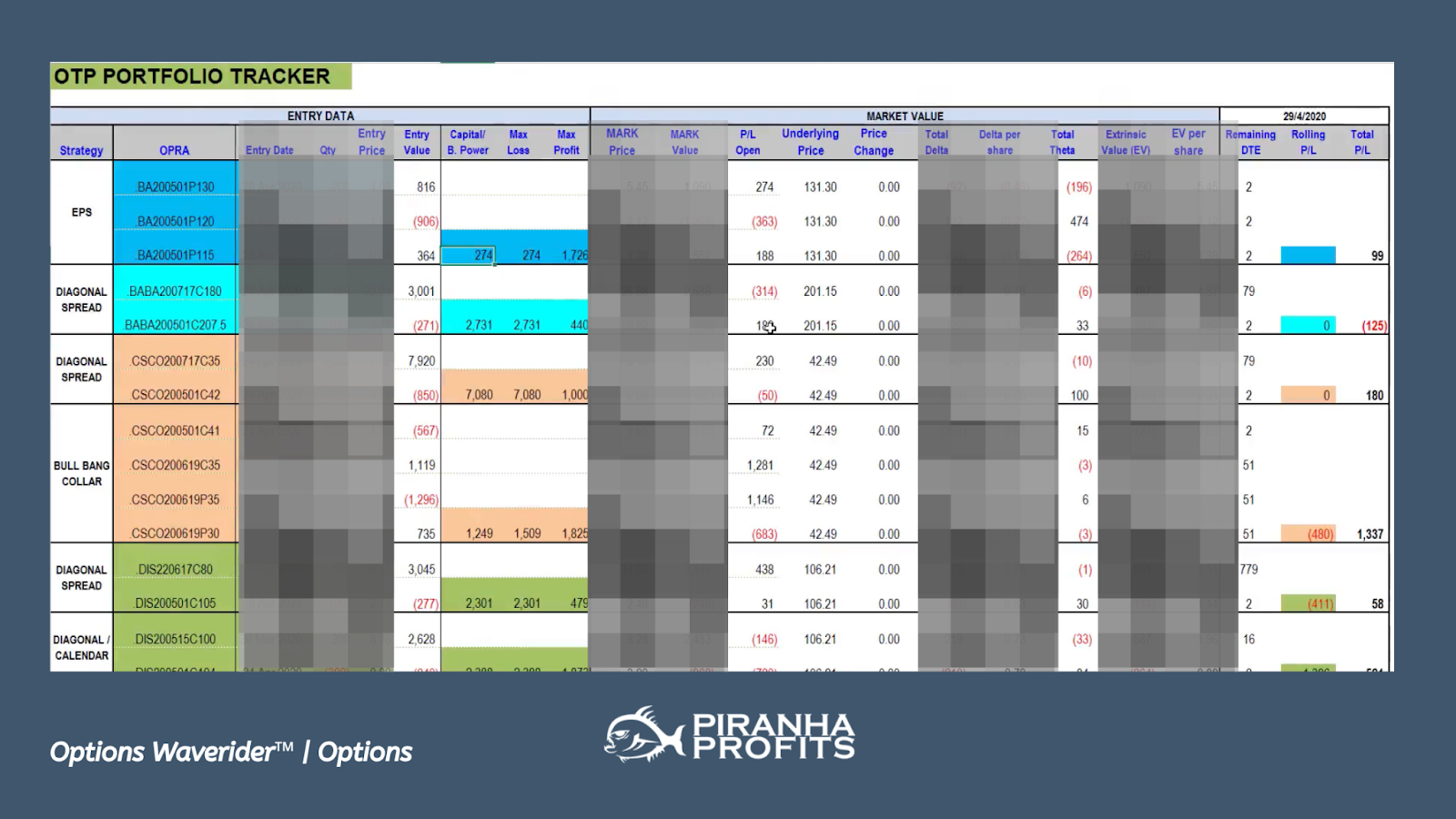
Options Portfolio Tracker by Options Waverider™ Piranha Profits
A portfolio tracker keeps your trading organized and your decisions data-driven. Here’s what you should track :
Entry Data: Records your trade setup. Strategy type, entry date, quantity, capital used, and risk/reward.Market Value: Shows how your trades are performing live through mark price, delta, theta, and underlying movement.
Profit & Loss: Tracks open, rolled, and total P/L so you know what’s working and what’s not.
Days to Expiration (DTE): Helps manage timing. Knowing when to roll, close, or let trades expire.
Together, these sections give you a clear view of your positions, performance, and progress.
Covered Call and Cash Secured Put Scanner to Find the Right Opportunities
When managing an options portfolio, scanning the market manually for setups can be time-consuming. That’s where scanners come in. Automated tools that filter through hundreds of stocks to find trades that meet your exact criteria. Whether you’re selling covered calls or cash-secured puts (CSPs), scanners help you focus only on high-quality, high-probability setups.
The example shown here highlights how a Covered Call and CSP Scanner displays important trade metrics such as premium yield, annualized return, dividend yield, and distance to strike easily, before executing a trade on your platform.
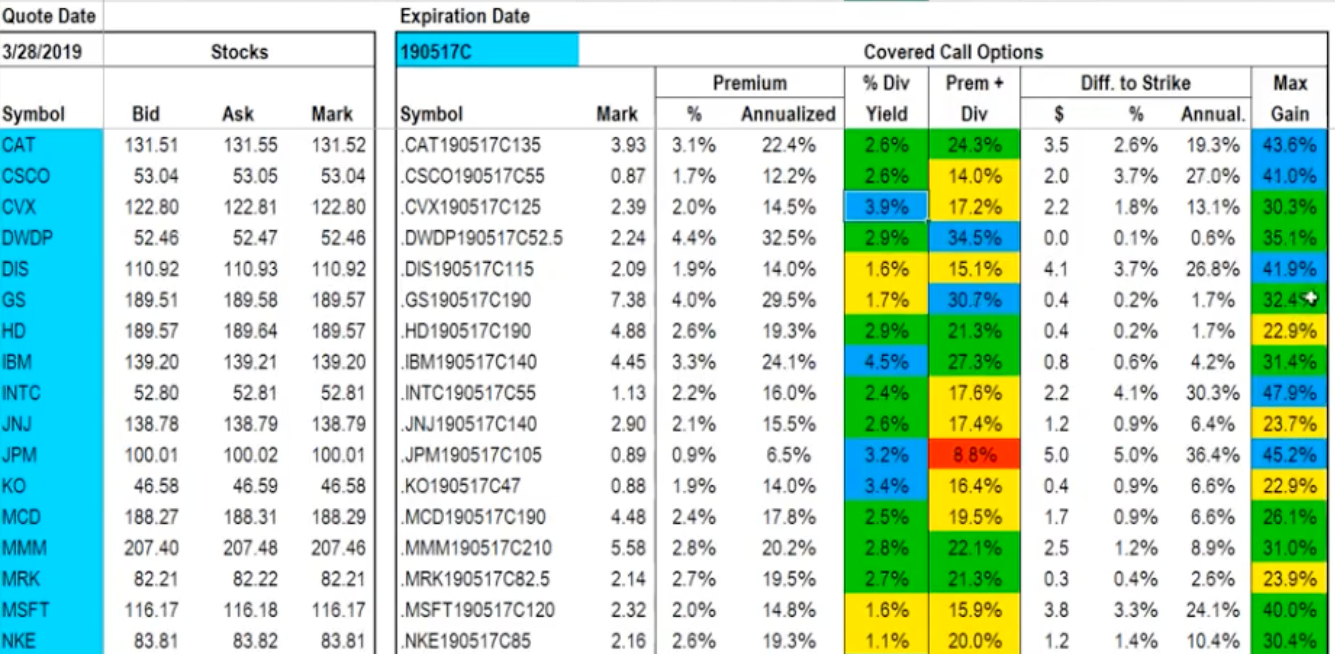
Options Scanner by Options Waverider™ Piranha Profits
Each column in the covered call scanner provides data that helps identify the best opportunities:
Symbol & Mark: The stock or option being evaluated and its current market price.Premium % / Annualized: Shows how much return you can expect from selling the option — annualized to compare opportunities across expirations.
Dividend Yield: Adds a second income source for dividend-paying stocks.
Premium + Dividend (%): Combines both income streams for total yield potential.
Diff. to Strike ($ / %): Measures how far the strike is from the current stock price.
Max Gain: The total percentage gain if the trade plays out perfectly (premium + potential upside).
These figures help traders immediately spot which stocks offer the best balance of premium yield, safety, and potential upside.
The Journey Ahead – Mastering Control Through Options
Now that you have reached the end of this course, you realize you’ve learned so much and can see with clarity how options work.
What once seemed complicated, the strikes, the Greeks, the premiums – now forms a clear structure. You’ve discovered that options aren’t about predicting what will happen next; they’re about deciding how you’ll respond when it does. It’s the shift from reacting to the market to controlling your outcomes that defines a disciplined trader.
Some traders stop here, satisfied with understanding the mechanics.
You can choose to go further. To refine your craft and turn knowledge into consistent, confident execution.
You’re ready to take that next step, explore our Options Waverider Program, where our professional traders share live setups, updates, and insights to help you apply what you’ve learned in real market conditions.

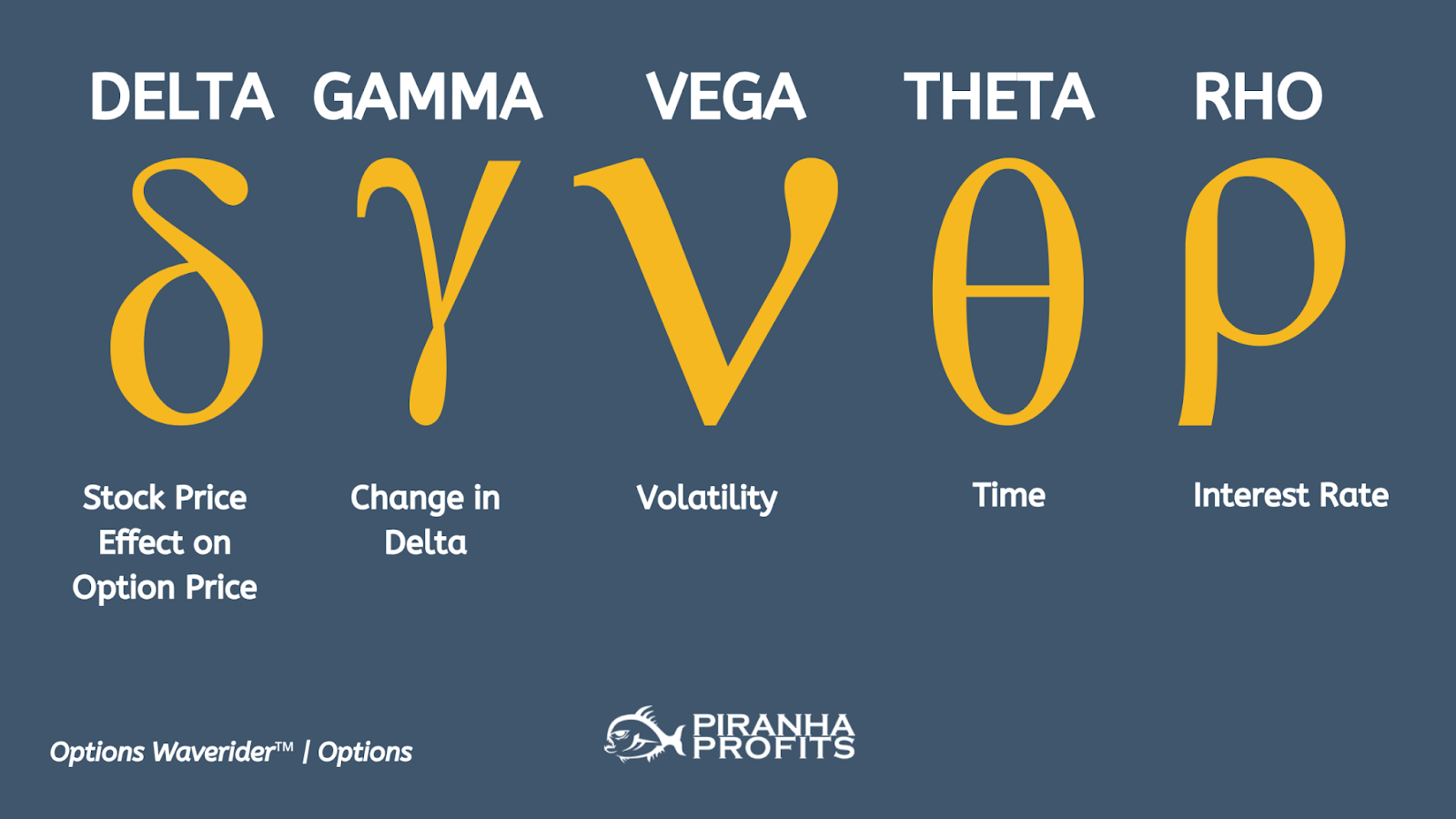





submit your comment